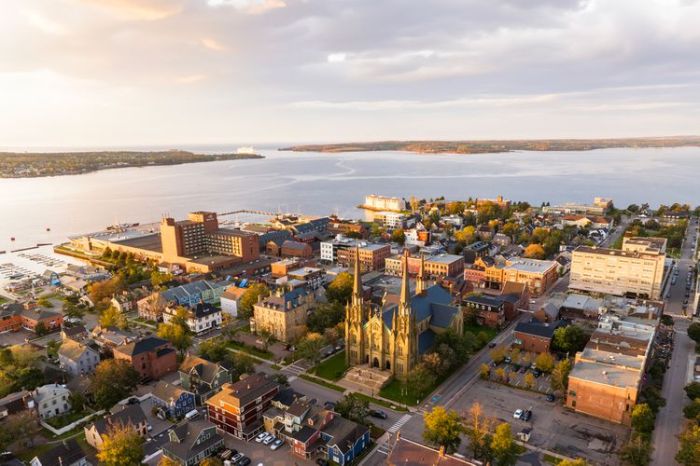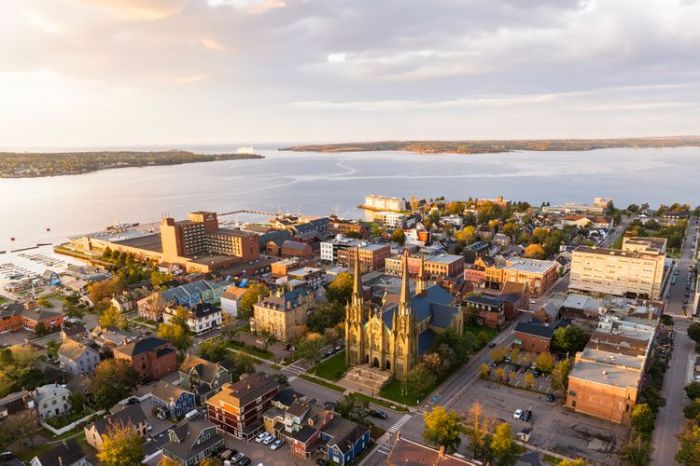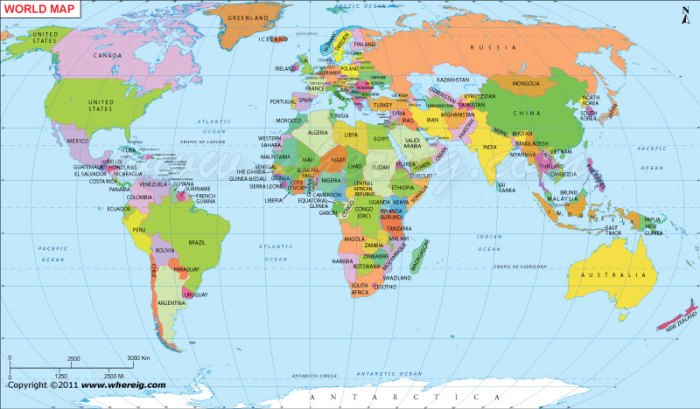Cheapest places to retire in Canada: Canada offers a variety of retirement destinations, but some are more affordable than others. This guide delves into the factors that contribute to a budget-friendly retirement in Canada, from housing costs and healthcare to lifestyle options and financial planning. We’ll explore specific cities and towns known for their affordability and compare their pros and cons, offering insights for retirees looking to make the most of their golden years while minimizing expenses.
Factors like proximity to amenities, climate, and community size all play a role in determining the overall cost of living. We’ll examine how these elements contribute to affordability in different regions. Understanding the nuances of each location is crucial for making an informed decision.
Introduction to Affordable Retirement in Canada: Cheapest Places To Retire In Canada
Retirement in Canada doesn’t have to mean sacrificing your lifestyle. Finding affordable retirement destinations can open doors to a fulfilling and cost-effective later life, allowing you to explore new communities and enjoy a comfortable retirement without breaking the bank. Understanding the factors that contribute to affordability in various Canadian locations is key to making an informed decision.Affordable retirement locations in Canada are often characterized by lower living costs compared to major metropolitan areas.
This can be attributed to factors such as property values, taxes, and the overall cost of goods and services. However, affordability isn’t solely about cost; it’s also about finding a place that aligns with your personal needs and preferences. The availability of healthcare, cultural amenities, and social activities are equally important considerations in the retirement decision-making process.
Factors Influencing Retirement Affordability
Several factors significantly impact the cost of retirement in a particular Canadian location. These include housing costs, healthcare expenses, local taxes, and the availability of recreational activities. A location with lower property values and lower taxes, for example, will naturally be more affordable. Furthermore, the proximity to healthcare facilities and the quality of local services also play a critical role in determining the overall affordability of a retirement destination.
Examples of Affordable Retirement Destinations
Canada offers a diverse range of communities known for their affordability. Smaller towns and rural areas often boast lower property costs than urban centres. For instance, communities in the Prairies, such as some areas of Saskatchewan and Alberta, frequently feature lower housing costs compared to cities like Toronto or Vancouver. The Maritimes also present a variety of affordable options, with charming coastal towns offering a slower pace of life and lower living costs.
Affordable vs. Cheap Retirement Options
While affordability focuses on a balance between cost and quality of life, a “cheap” retirement might compromise essential elements like access to healthcare or social activities. A truly affordable retirement considers both the financial implications and the desired lifestyle. For example, a rural community might offer lower housing costs, but with limited access to specialized medical care. The choice between affordability and cheapness hinges on personal priorities.
Retirement Cost Breakdown
Understanding the various components of retirement costs is essential for making an informed decision.
| Category | Description | Example Impact |
|---|---|---|
| Housing | Property values, rent, utilities | Lower property taxes and smaller home sizes can drastically reduce housing costs. |
| Healthcare | Medical services, prescriptions, insurance | Proximity to hospitals and availability of local healthcare services impact costs. |
| Activities | Entertainment, travel, social engagements | Access to cultural events and recreational opportunities can vary significantly between locations. |
| Taxes | Provincial and local taxes | Some provinces offer lower tax rates than others, influencing the overall cost of living. |
| Food | Groceries, dining out | The cost of groceries and restaurant meals can fluctuate depending on the local economy. |
Housing Costs in Budget-Friendly Retirement Areas
Finding affordable housing in Canada for retirement is crucial for a comfortable and fulfilling later life. This section dives into the average housing costs in various Canadian cities suitable for retirees, examining different property types and their affordability across provinces. We’ll also look at the availability of affordable housing options within retirement communities, and the factors impacting housing costs in these areas.
Average Housing Costs in Canadian Cities
Housing costs vary significantly across Canada, influenced by factors such as location, demand, and local economies. Understanding these variations is vital for retirees looking to secure a budget-friendly home. Different Canadian cities offer various housing options catering to different needs and budgets.
Affordability of Different Property Types
Apartments, houses, and condominiums each have unique characteristics impacting their cost. Apartments typically offer lower upfront costs but might have fewer amenities compared to houses. Houses offer more space and customization but usually command a higher price tag. Condominiums strike a balance, offering shared amenities while being more affordable than houses in certain locations.
Comparison of Housing Costs Across Provinces
Housing costs fluctuate considerably across provinces. For example, the average cost of a house in Ontario might be higher than the average cost of a house in Prince Edward Island. This difference is attributed to factors like local economies, population density, and demand for housing in specific regions. These regional variations are important to consider when planning a retirement location.
Affordable Housing Options in Retirement Communities
Retirement communities often provide affordable housing options, sometimes including amenities such as assisted living or shared recreational facilities. These communities are designed for senior living, and their pricing structure often reflects the unique needs and services they provide. However, not all retirement communities offer the same level of affordability, so research is essential.
Thinking about the cheapest places to retire in Canada? While researching, I stumbled upon some fascinating information about the best time to visit Phoenix, which might surprise you. For example, if you’re looking to experience the city at its most pleasant, you should definitely check out best time to visit phoenix for the ideal time to visit.
Ultimately, finding the most affordable retirement spots in Canada is still my primary focus.
Factors Affecting Housing Costs
Several factors influence housing costs. Location plays a pivotal role, with proximity to amenities, services, and cultural attractions driving up prices. The size of the property and the inclusion of specific amenities, such as in-home care or access to parks, can also significantly impact the final cost. These considerations need to be evaluated based on individual needs and preferences.
Average House Prices in Different Regions (Table)
| Region | Average House Price (CAD) |
|---|---|
| British Columbia (Vancouver) | $1,200,000 – $1,500,000 |
| Ontario (Toronto) | $800,000 – $1,000,000 |
| Alberta (Calgary) | $500,000 – $700,000 |
| Manitoba (Winnipeg) | $350,000 – $500,000 |
| Atlantic Provinces (e.g., New Brunswick) | $250,000 – $400,000 |
Note: These are approximate ranges and can vary based on specific neighborhoods and individual properties.
Healthcare Considerations for Retiring on a Budget
Retiring on a budget in Canada often means carefully considering healthcare costs, a crucial factor in long-term financial planning. Understanding the accessibility and affordability of healthcare services in various provinces is essential for potential retirees. This section delves into the specifics of provincial healthcare systems, associated costs, and senior-specific programs to help navigate these important decisions.Canadians enjoy universal healthcare, a cornerstone of the country’s social safety net.
However, the cost of specific medical services and the variations across provinces can still significantly impact retirement budgets. Knowing these details allows for proactive planning and informed choices.
Accessibility and Affordability of Healthcare Services
The Canadian healthcare system is publicly funded through provincial and territorial governments. This universal access means that all residents, including retirees, have the right to essential medical services. However, while the system is designed to be comprehensive, some costs aren’t covered by the basic system, which means that retirees might face additional expenses. These additional expenses can include prescription drugs, dental care, and some specialized treatments.
Role of Provincial Healthcare Systems
Each province and territory in Canada has its own healthcare system, administered and funded by the respective government. While the basic principles of universal coverage remain consistent, there are variations in the specific services offered, coverage levels, and waiting times. These differences are key to understanding how healthcare costs might vary across different retirement destinations.
Costs Associated with Medical Care, Prescriptions, and Other Healthcare Services
The cost of medical care, prescriptions, and other services in Canada is not uniform across the country. The actual expenses depend on factors like the specific treatment, the healthcare provider, and the province in which care is received. Out-of-pocket expenses can vary greatly and are often not fully covered by the basic system. Prescription drugs, for example, often require additional coverage or personal financial contribution.
Availability of Senior-Specific Healthcare Programs
Many provinces offer specific programs and services designed to support seniors. These programs often include home care, assisted living options, and support for chronic conditions. Understanding the availability and details of these programs in a particular province is vital for retirement planning.
Comparison of Healthcare Quality in Different Regions
Healthcare quality is generally considered high across Canada, but there can be regional variations. Factors like the density of medical professionals, access to specialized facilities, and the sophistication of specific services can differ across provinces. However, the quality of care in most Canadian provinces remains consistently high.
Costs of Various Healthcare Services in Different Provinces
| Province | Estimated Annual Prescription Drug Cost (for an average senior) | Estimated Annual Dental Care Cost (for an average senior) | Estimated Annual Home Care Cost (if required) |
|---|---|---|---|
| Alberta | $500-$1500 | $300-$1000 | $10,000-$20,000 |
| British Columbia | $600-$1800 | $400-$1200 | $12,000-$24,000 |
| Manitoba | $400-$1200 | $250-$750 | $8,000-$16,000 |
Note: These are estimated costs and can vary significantly based on individual needs and circumstances. Consult with healthcare providers and provincial government resources for specific details.
Lifestyle and Amenities in Budget-Conscious Retirement Locations

Retiring on a budget doesn’t mean sacrificing your quality of life. Many affordable retirement destinations offer surprisingly vibrant and engaging communities. Understanding the range of lifestyle options and amenities available is crucial for choosing a location that truly suits your needs and interests. From social activities to recreational opportunities, these areas often provide a welcoming and fulfilling retirement experience.Finding the right balance between affordability and desirable amenities is key to a happy retirement.
Budget-friendly locations often excel in fostering strong local communities, where residents readily engage in social activities and build connections. This social aspect is essential for maintaining well-being and preventing feelings of isolation, a critical consideration for retirees.
Social Activities and Community Engagement
Strong community ties are often a defining characteristic of budget-friendly retirement destinations. These areas prioritize fostering a sense of belonging, providing ample opportunities for residents to connect with each other. Many communities organize social events, clubs, and activities to encourage interaction and participation. These activities not only provide opportunities for socializing but also create a supportive environment where residents can build friendships and a strong sense of belonging.
Planning a retirement getaway in Canada? Finding the cheapest places to retire can be tricky, but it’s totally doable! Thinking about destination weddings and how to travel with an engagement can give you some cool ideas for locations, too. For example, you could consider small towns in the Maritimes or the prairies as potential retirement spots and use trip ideas destination weddings how to travel with engagement to brainstorm unique venues and transportation options.
Ultimately, the cheapest places often offer the most charm and unique experiences for your retirement adventure!
Examples of Activities in Retirement Communities
Numerous activities cater to diverse interests in budget-friendly retirement communities. These can include book clubs, card games, exercise classes, potlucks, volunteer opportunities, and local interest groups. For example, some communities organize outings to local historical sites, parks, or farmers’ markets, fostering a sense of shared exploration and enjoyment. Many communities also offer opportunities to participate in local celebrations, festivals, and cultural events.
This creates a strong sense of connection and shared experiences within the community.
Comparison of Amenities Across Regions
The quality of amenities varies across different budget-friendly retirement regions in Canada. Some areas might offer more extensive recreational facilities, while others may focus on community events and social gatherings. Factors such as the size of the community, the availability of local businesses, and the overall culture of the area contribute to the unique character of each region.
It’s essential to research specific locations to identify the amenities that align with your preferences and lifestyle.
Cultural Experiences and Attractions
Budget-conscious retirement destinations often boast a rich tapestry of local culture and attractions. These can include historical landmarks, museums, art galleries, local festivals, and opportunities to engage with local artisans. For example, many small towns and rural communities offer unique cultural experiences, such as traditional music performances, craft fairs, and heritage tours.
Recreational Opportunities
Access to parks, trails, and outdoor recreational activities is essential for retirees seeking an active and healthy lifestyle. Many budget-friendly retirement communities offer ample opportunities for outdoor pursuits. Hiking, biking, fishing, and other activities can be enjoyed in close proximity to your residence. The presence of parks, trails, and recreational areas often contributes significantly to the overall quality of life in a community.
Activities and Amenities in Selected Areas
| Region | Social Activities | Recreational Opportunities | Cultural Experiences |
|---|---|---|---|
| Small Town in the Maritimes | Book clubs, knitting circles, community potlucks | Hiking trails, fishing, local farmers’ markets | Historical society events, local craft fairs |
| Rural area in the Prairies | Card games, exercise classes, volunteer groups | Parks, biking trails, fishing | Local art galleries, museum visits, small-town festivals |
| Small City in the Interior of BC | Senior centers, walking groups, clubs for shared hobbies | Golf courses, parks, hiking trails | Local theater productions, cultural festivals |
Financial Planning for a Budget-Friendly Canadian Retirement
Retiring comfortably in Canada on a budget requires careful financial planning. This involves more than just saving; it’s about strategically managing your finances to ensure you have enough income to cover essential expenses and maintain your desired lifestyle without outliving your savings. A well-defined plan considers various factors, from current savings and investment options to potential government support and expense reduction strategies.A robust retirement plan considers the unique financial circumstances of each individual.
This includes assessing current assets, evaluating anticipated expenses, and exploring various savings and investment avenues. This proactive approach ensures a smooth transition into retirement, allowing for financial freedom and peace of mind.
Retirement Budget Planning Strategies
Developing a realistic retirement budget involves a comprehensive evaluation of projected expenses and income sources. This process requires careful consideration of anticipated costs for housing, healthcare, travel, entertainment, and other essential necessities. Accurate projections are essential for creating a sustainable retirement plan.
Importance of Saving and Investing for Retirement, Cheapest places to retire in canada
Saving and investing early for retirement significantly impacts your financial well-being during those golden years. Consistent contributions to retirement savings plans, like Registered Retirement Savings Plans (RRSPs) or Tax-Free Savings Accounts (TFSAs), can accumulate substantial funds over time. These plans offer tax advantages, compounding your returns and maximizing your savings. The earlier you start saving, the more time your investments have to grow.
For instance, a $500 monthly contribution to an RRSP starting at age 30 can accumulate significantly more than the same contribution starting at age 50.
Tips for Reducing Expenses During Retirement
Reducing expenses is a crucial aspect of achieving a budget-friendly retirement. Strategies include reviewing current spending habits, negotiating bills, and exploring affordable alternatives for housing and entertainment. Utilizing technology for financial management can further enhance efficiency. Seeking expert advice for optimizing financial strategies can provide valuable guidance.
- Review and Negotiate Bills: Regularly reviewing and negotiating utility bills, insurance premiums, and other recurring expenses can lead to substantial savings. Consider switching providers to compare prices and find the most affordable options. Don’t hesitate to ask for discounts or better rates.
- Housing Options: Downsizing or relocating to a more affordable area can significantly reduce housing costs. Evaluating various housing options, from smaller apartments to shared living arrangements, can provide considerable savings.
- Lifestyle Adjustments: Adjusting your lifestyle to align with your budget can be beneficial. Considering more affordable leisure activities and entertainment options, and prioritizing experiences over material possessions, can contribute to a more budget-friendly retirement.
Role of Government Programs and Benefits for Retirees
Canadian government programs provide valuable support for retirees. These include Old Age Security (OAS) and Guaranteed Income Supplement (GIS), which provide crucial financial assistance. Understanding eligibility criteria and benefits available through these programs is essential for maximizing support. Provincial and territorial programs can also offer supplementary assistance.
Comparing Different Retirement Savings Plans
Different retirement savings plans have varying features and benefits. RRSPs offer tax deductions on contributions, while TFSAs allow for tax-free growth and withdrawals. Understanding the implications of each plan based on your specific circumstances is essential. Professional financial advisors can provide tailored recommendations for optimizing your savings strategy.
| Plan Type | Key Features | Tax Implications |
|---|---|---|
| RRSP | Tax-deductible contributions, tax-deferred growth | Taxed on withdrawals in retirement |
| TFSA | Tax-free growth and withdrawals | No tax on contributions or withdrawals |
| RESP | For saving for children’s education | Tax-advantaged savings |
Creating a Detailed Retirement Budget Template
A detailed retirement budget template Artikels projected income and expenses for the duration of retirement. It includes anticipated sources of income, such as pensions, investments, and government benefits. Essential expenses like housing, healthcare, and daily living costs are meticulously documented. Regular reviews and adjustments to the budget based on changing circumstances are crucial. A well-structured template is a vital tool for financial security during retirement.
A detailed retirement budget template should be personalized to reflect individual needs and circumstances.
Looking for the cheapest places to retire in Canada? While researching affordable retirement destinations, I stumbled across some fascinating information about the vibrant atmosphere of the Greek Carnival in Athens. Checking out the spotlight on the carnival in Athens really sparked my interest in exploring the cultural richness of the region. Perhaps the low cost of living in some Canadian towns could open up opportunities for experiencing similar events, making retirement a truly enriching adventure!
Illustrative Case Studies of Affordable Retirement
Finding affordable retirement destinations in Canada requires careful consideration of various factors. This section explores real-life examples of individuals who successfully navigated the process, highlighting their experiences and strategies. These case studies will illustrate the diverse possibilities and potential challenges of retiring on a budget in different parts of Canada.Retiring on a budget in Canada is achievable with thorough research and careful planning.
The experiences of these individuals offer valuable insights into the practical aspects of relocating for retirement and adapting to a new lifestyle. Successful retirement transitions often involve a blend of financial prudence, lifestyle adjustments, and a proactive approach to health and well-being.
Case Study 1: The Saskatchewan Settler
This individual, a retired teacher, opted for Saskatchewan due to its lower housing costs compared to major cities. They downsized significantly, moving from a large home in a metropolitan area to a smaller, more affordable residence in a rural Saskatchewan community. Their strategy focused on maximizing their existing retirement savings while minimizing expenses in areas like utilities and transportation.
They also explored local volunteer opportunities to stay active and engaged in their community. The lower cost of living in Saskatchewan proved beneficial, allowing them to enjoy a more comfortable retirement lifestyle without depleting their savings.
Case Study 2: The Atlantic Coast Couple
A retired couple from a larger city in Ontario chose to retire in the Atlantic provinces. The allure of a slower pace of life and a lower cost of living played a crucial role in their decision. They focused on securing affordable housing in a coastal town, utilizing their existing savings and selling their larger property to fund the move.
Their experience included exploring local activities, such as fishing and hiking, which helped them embrace a new lifestyle while keeping costs down. The draw of fresh seafood and lower overall costs made this a financially rewarding choice.
Case Study 3: The Alberta Acreage Enthusiast
This case study showcases a retiree who opted for an affordable lifestyle in rural Alberta. Their decision to purchase acreage in a smaller town was driven by their desire for a peaceful and nature-filled retirement. This individual utilized government programs designed to assist retirees with homeownership in rural areas. They reduced their expenses by relying on locally sourced food and entertainment, creating a self-sufficient retirement.
The trade-off was a somewhat reduced social life compared to a city, but the tranquility and lower costs of rural living outweighed these potential drawbacks.
Case Study Comparison and Insights
| Case Study | Location | Key Strategies | Benefits | Drawbacks |
|---|---|---|---|---|
| Saskatchewan Settler | Rural Saskatchewan | Downsizing, maximizing savings, minimizing expenses | Lower housing costs, reduced utilities, accessible healthcare | Potentially limited social opportunities, some distance from major amenities |
| Atlantic Coast Couple | Atlantic Province | Affordable housing, reduced spending on entertainment, exploring local activities | Lower cost of living, slower pace of life, fresh seafood | Potential for seasonal weather changes, distance from family and friends in other provinces |
| Alberta Acreage Enthusiast | Rural Alberta | Utilizing government programs, locally sourced food, self-sufficiency | Affordable acreage, peaceful environment, reduced expenses | Limited access to urban amenities, potentially fewer social opportunities |
Research and planning are crucial before relocating for retirement. Factors such as healthcare accessibility, transportation options, and local amenities need careful consideration. Each location offers unique advantages and disadvantages, and it is vital to assess your specific needs and preferences. A comprehensive understanding of the chosen area’s infrastructure and support systems will lead to a smoother transition and a more fulfilling retirement.
Detailed Information on Specific Budget-Friendly Locations

Retiring on a budget in Canada offers exciting possibilities, with numerous charming towns and cities providing a comfortable lifestyle without breaking the bank. This section delves into specific locations known for their affordability, examining the cost of living, housing, healthcare, and amenities. We’ll also consider the local economy, transportation, and community atmosphere, providing a well-rounded picture for prospective retirees.Exploring affordable retirement destinations requires a careful analysis of various factors.
Understanding the cost of living, housing market trends, and healthcare accessibility in a particular region is crucial. Furthermore, the quality of life, community atmosphere, and local economy all contribute to the overall suitability of a location. Detailed information on specific locations helps potential retirees make informed decisions.
Cost of Living in Budget-Friendly Cities
The cost of living in a region significantly impacts retirement budgets. Factors like housing, groceries, utilities, and transportation costs must be carefully evaluated. Affordable cities often offer lower property prices, especially for housing. This can lead to substantial savings for retirees. Understanding the local cost of groceries and everyday necessities is also crucial.
By comparing these costs across different regions, retirees can effectively manage their budget and choose a location that best fits their financial needs.
Housing Costs and Availability
Housing costs are a major consideration for retirees. Affordable cities frequently offer a wider selection of housing options, including smaller homes, apartments, or even townhouses. The availability of affordable housing options often correlates with the local housing market. Understanding the dynamics of the market can help retirees make more informed decisions regarding their housing needs.
Healthcare Accessibility and Costs
Healthcare is a critical aspect of retirement planning. Areas with a lower cost of living often also have accessible healthcare systems. The proximity to medical facilities and the cost of healthcare services, such as doctor visits, prescription drugs, and long-term care, should be evaluated carefully.
Community Atmosphere and Quality of Life
A desirable retirement location offers more than just affordability. The community atmosphere and quality of life play a vital role in long-term happiness. The availability of recreational activities, cultural events, and social opportunities should be considered. A strong sense of community often translates to a higher quality of life for retirees.
Local Economy and Job Market
A robust local economy can contribute to the overall well-being of retirees. A strong economy can provide various opportunities for part-time work, entrepreneurial ventures, or volunteer activities. Understanding the local job market, particularly if part-time work is desired, can help retirees make a more informed decision.
Transportation Options
Reliable transportation options are crucial for maintaining an active lifestyle in retirement. Understanding the availability of public transportation, walking paths, and bicycle routes is essential. Proximity to major transportation hubs, such as airports or train stations, should be factored into the decision-making process.
Key Statistics of Budget-Friendly Locations
| City/Town | Average Home Price (CAD) | Average Grocery Cost (Weekly) (CAD) | Average Doctor Visit Cost (CAD) | Community Description |
|---|---|---|---|---|
| Moncton, New Brunswick | $250,000 | $150 | $100 | Friendly, close-knit community with a strong sense of local pride, excellent for outdoor activities. |
| Saskatoon, Saskatchewan | $300,000 | $180 | $120 | Large, growing city with a mix of urban and rural amenities, offering a variety of recreational opportunities. |
| Prince Albert, Saskatchewan | $200,000 | $120 | $90 | Smaller city with a more laid-back atmosphere, ideal for those seeking a slower pace of life. |
Final Review
In conclusion, retiring affordably in Canada is achievable with careful planning and research. This guide provides a comprehensive overview of the key considerations, allowing you to weigh the costs and benefits of various locations. Ultimately, the “cheapest” place to retire is subjective, depending on individual priorities and preferences. We encourage you to thoroughly evaluate your needs and desires to find the perfect retirement haven within Canada’s diverse landscape.




